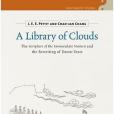《A Library of Clouds》是香港中文大學出版社出版的圖書,作者是J. E. E. Pettit,Chao-jan Chang
基本介紹
- 中文名:A Library of Clouds
- 作者:J. E. E. Pettit、Chao-jan Chang
- 出版時間:2020年8月
- 出版社:香港中文大學出版社
- 頁數:376 頁
- ISBN:9789882371811
- 定價:65.00 美元
- 裝幀:Hardcover
內容簡介
From early times, Daoist writers claimed to receive scriptures via revelation from heavenly beings. In numerous cases, these writings were composed over the course of many nights and by different mediums. New revelations were often hastily appended, and the resulting unevenness gave rise to the impression that Daoist texts often appear slapdash and contain contradictions. A Lib...(展開全部) From early times, Daoist writers claimed to receive scriptures via revelation from heavenly beings. In numerous cases, these writings were composed over the course of many nights and by different mediums. New revelations were often hastily appended, and the resulting unevenness gave rise to the impression that Daoist texts often appear slapdash and contain contradictions. A Library of Clouds focuses on the rewriting of Daoist scriptures in the Upper Clarity (Shangqing) lineage in fourth- and fifth-century China. Scholarship on Upper Clarity Daoism has been dominated by attempts to uncover “original” or “authentic” texts, which has resulted in the neglect of later scriptures— including the work fully translated and annotated here, the Scripture of the Immaculate Numen, one of the Three Wonders (sanqi) and among the most prized Daoist texts in medieval China. The scripture’s lack of a coherent structure and its different authorial voices have led many to see it not as a unified work but the creation of different editors who shaped and reshaped it over time. A Library of Clouds constructs new ways of understanding the complex authorship of texts like the Scripture of the Immaculate Numen and their place in early medieval Daoism. It stresses their significance in understanding the ways in which manuscripts were written, received, and distributed in early medieval China. By situating the scripture within its immediate hagiographic and ritual contexts, it suggests that this kind of revelatory literature is best understood as a pastiche of ideas, a process of weaving t

